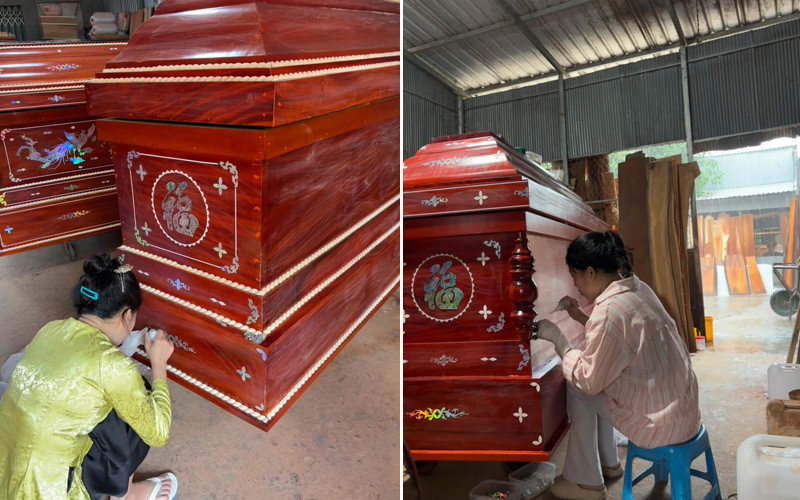
More and more women are pursuing "tough" jobs out of passion—not only earning money and gaining societal recognition but also helping dismantle gender stereotypes in professional fields.
Meaning of coffin inlay
For many people, coffins evoke unease, but for Nguyen Thi Lan Kieu, born in 1993, from Dong Thap, they are familiar objects that she touches and beautifies daily.
Kieu has spent nearly three years in a trade which is "not for the faint-hearted." She and her husband run a full-service funeral business in Cao Lanh City.
Her most confident and cherished task is "can hom”, or coffin decoration. Weekly, she receives coffins from craftsmen, then personally decorates them to look more beautiful and striking.
"Coffin decoration means inlaying or attaching shells to objects. Depending on the wood, I choose materials—sometimes paper, sometimes pre-shaped plastic," Kieu explained.
Each decorator has their own style. Kieu often inlays dragons, phoenixes, or rural scenes, believing they’re beautiful and spiritually meaningful.
After her decoration, craftsmen repaint the coffin for a glossy finish. No longer plain, it becomes distinctive.
For Kieu, decorating coffins makes the deceased’s final journey more meaningful and solemn. The living can therefore feel at ease.
"Most people want simplicity, so I avoid over-ornamentation. Buyers, often in a rush, ask about wood and price, rarely noticing patterns or designs. Still, I work with heart, arranging everything harmoniously," she said.
Kieu follows no strict rules. She believes the key is working with sincerity, respecting the deceased, and honoring the family’s wishes.
"We have one absolute rule: honoring the trade’s ancestors. On the 2nd and 16th of each lunar month, I offer fruits, incense, and candles with devotion. You can’t disrespect the ancestors," Kieu said.
Preparing the deceased
Coffin decoration is just one part of Kieu’s funeral services. She, her husband, and a few staff also provide full embalming for the deceased.
After a family books, she prepares embalming items, decorations, mourning attire, candles, and incense, and comes to clients’ homes 3-4 hours before the ceremony.
There, her team splits tasks—hanging curtains, preparing coffin items, writing obituaries, drafting thank-you notes, or setting up frames.
"Sometimes, my husband and I bathe and dress the deceased for the family, ensuring they’re neat before entering the coffin. I’m not scared. Studying Buddhist scriptures, I understand the theory of rebirth and karma. The deceased are just like us—just resting forever," Kieu said.
Like coffin decoration, she does this with seriousness and care, wanting the deceased’s final journey to be flawless.
"After embalming, we leave, returning for the burial day. Only when they rest in the earth is it truly done," she explained.
Since starting her business, Kieu has never felt haunted or had strange dreams. She sees it as a normal job, despite being called an "iron woman" or "fearless."
"We have no rituals—just shower after work, not with herbs or fire to dispel cold, but for coolness and cleanliness," she said.
Heart-wrenching stories
In a trade tied to death, Kieu has faced many poignant moments.
She once handled a family’s funeral when the husband died, and 25 days later, the wife followed. In another case, a man, healthy in the morning, died by afternoon on a hammock. His family was so poor they couldn’t afford a coffin.
"Their plight was heartbreaking, so we provided free services. The wife collected condolence money, and after expenses, had VND3 million left. She gave the amount of money to me, but I refused the money, telling her to buy rice for her kids," Kieu recounted.
Witnessing farewells, losses, and tears, Kieu learned much. Previously, she and her husband often bickered. Now, working together, they’ve softened, learning to curb anger quickly.
"You live today, unsure of tomorrow—so love while you can, cherish every joyful day. Years in this trade, I know life’s impermanence better than most," she said.
Thanh Minh